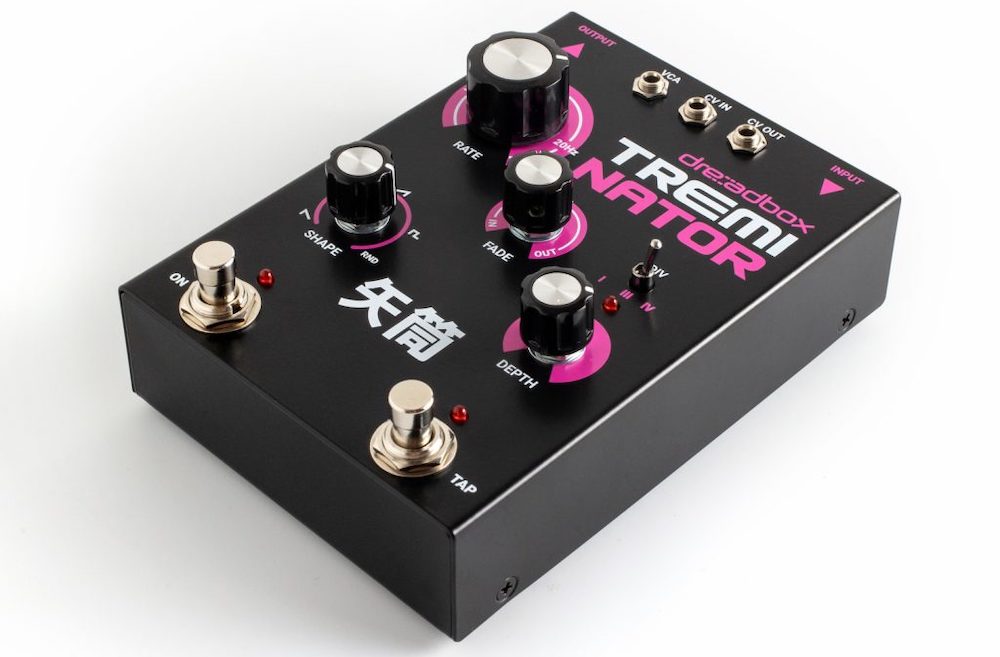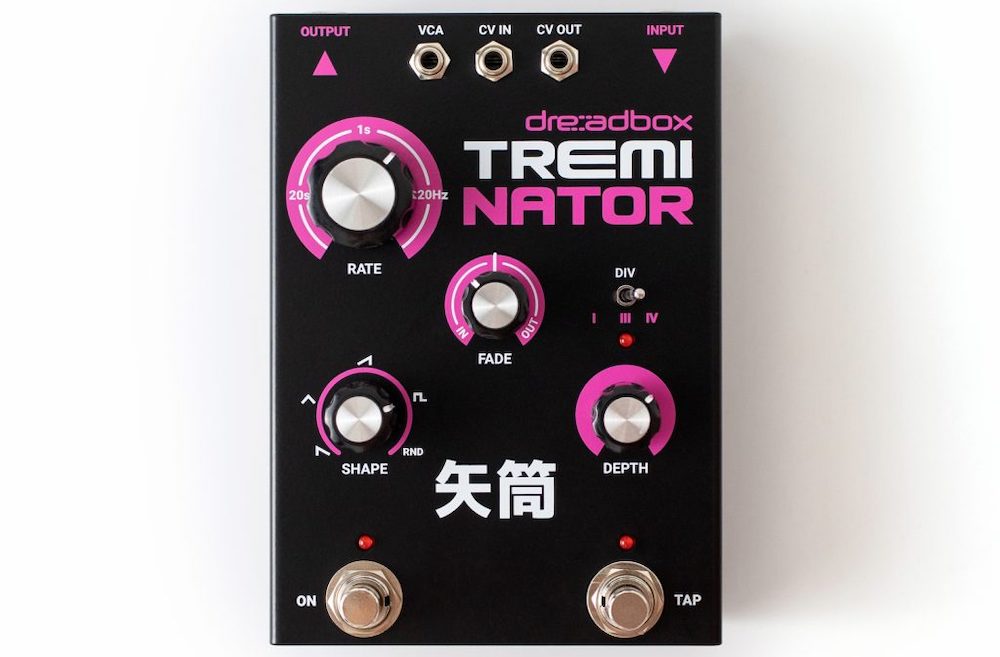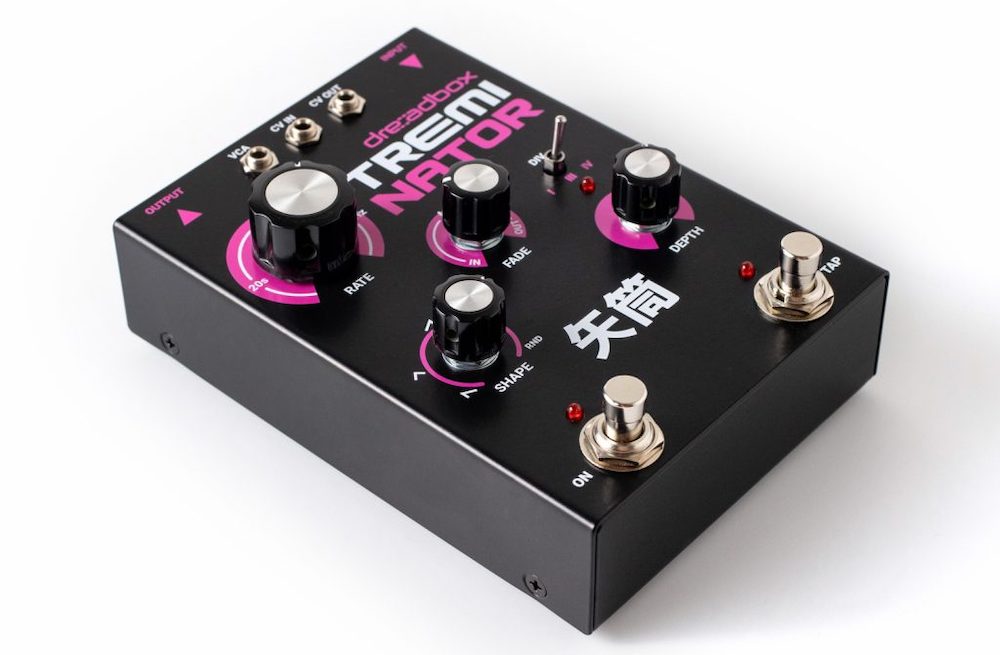Tremolo with a twist, Dreadbox’s latest effect combines analogue synth circuits to create an expressive, versatile pedal. Greg Scarth finds out more.

Launched alongside the new Raindrops delay/reverb, the Dreadbox Treminator is described as a ‘smashing tremolo’, but another way to look at it would be as the amplifier section of an analogue synth, packaged into an effects pedal. One of the final circuits in a synth is typically a voltage-controlled amplifier (VCA) which allows you to control the level of the audio signal. Dreadbox are experts at designing analogue synths, so it makes sense for them to use a bit of that expertise here: the Treminator is a tremolo pedal based around a synth-style analogue VCA with digital control, making it a versatile and characterful take on this classic effect.
We’ve been impressed by all the effects in the Dreadbox range to now, so expectations are high for the Treminator. A common theme has been the way the Athenian boutique brand have come up with clever twists on familiar effects like delays and fuzz boxes. Tremolo is fundamentally a very simple effect, created by modulating the volume of a signal up and down repeatedly to create a sense of movement. It was included as a built-in effect in guitar amplifiers as far back as the 1940s, but Dreadbox’s take on the process is an entirely new concept. What we have here is a tremolo pedal which can be used expressively by synth players and electronic producers as well as guitarists and bass players.

In terms of basic functionality, the Treminator ticks the usual tremolo boxes. You’ve got control of wave shape offering five different waveforms (triangle, square, saw up and down, random) plus the rate and depth of the effect. The latter two control the speed of the digital LFO (low-frequency oscillator) and how far that control signal modulates the VCA. Like most of Dreadbox’s pedals, the Treminator is a mono effect rather than stereo, but that means it’s well suited to guitar, bass and most analogue synths. Lots of Dreadbox’s effects are also good on drum machines, but this is one case where the applications are limited; you could use it to add movement to a hi-hat or percussion part, but tremolo is generally best on longer, sustained notes. With that accepted, the range of effects is quite impressive. LFO speed can be adjusted all the way from 20 seconds per cycle through to an audio-rate 220 Hz. At audio-rate frequencies, the effect is a basic implementation of amplitude modulation, which sounds similar to ring modulation, i.e. a twangy, metallic clang which can be tweaked by adjusting the LFO frequency and wave shape.

The Treminator packs the obvious tremolo features like tap tempo and divisions of the rate via a three-way toggle switch, but it’s also got some more advanced features hidden away. As with the Raindrops pedal, the Treminator packs a few secondary functions when you hold down the ON switch to use it as a shift button. These revolve around the Fade knob in the centre of the pedal, which allows you to fade in and out over the chosen depth range of the tremolo effect. It’s got some value as a manual control, but the real point is to control it via the Treminator’s signal-to-gate sensor. This generates a trigger whenever the level of the incoming audio signal goes above a preset threshold, which in turn can be used to trigger the waveform reset feature (restarting the LFO for each trigger), fading the LFO in or out, or modulating the tremolo rate. When you feed the pedal a signal with varying output level – a guitar, or a velocity-sensitive synth, for example – you can set the threshold to give expression and hands-free control of how the effect responds. The shift functions probably aren’t as transformative to the operation of the pedal as those on the Raindrops, but they are important, allowing you to adjust the threshold of the gate generator, turn on and off waveform reset and control the rate expression. What’s notably different to the Raindrops is that the Treminator includes patch points on the front panel, like you’ll find on most other Dreadbox effects. In this case, CV inputs allow you to control the VCA level and LFO rate, while an LFO output allows you to modulate other gear. Ideal for integrating the Treminator with patchable synths and Eurorack modules.

At just under £160, the Treminator is excellent value. There are cheaper tremolo pedals available, such as the Electro-Harmonix Nano Pulsar, but the Treminator is more versatile. It’s a pedal which encourages you to think differently about tremolo and treat it as more than just a basic effect. The implementation of the signal-to-gate sensor is probably the pedal’s most impressive feature, giving an interesting, responsive feel to the way you can control the effect depending on how you play. Another hit from Dreadbox.
Greg Scarth
More info/buy